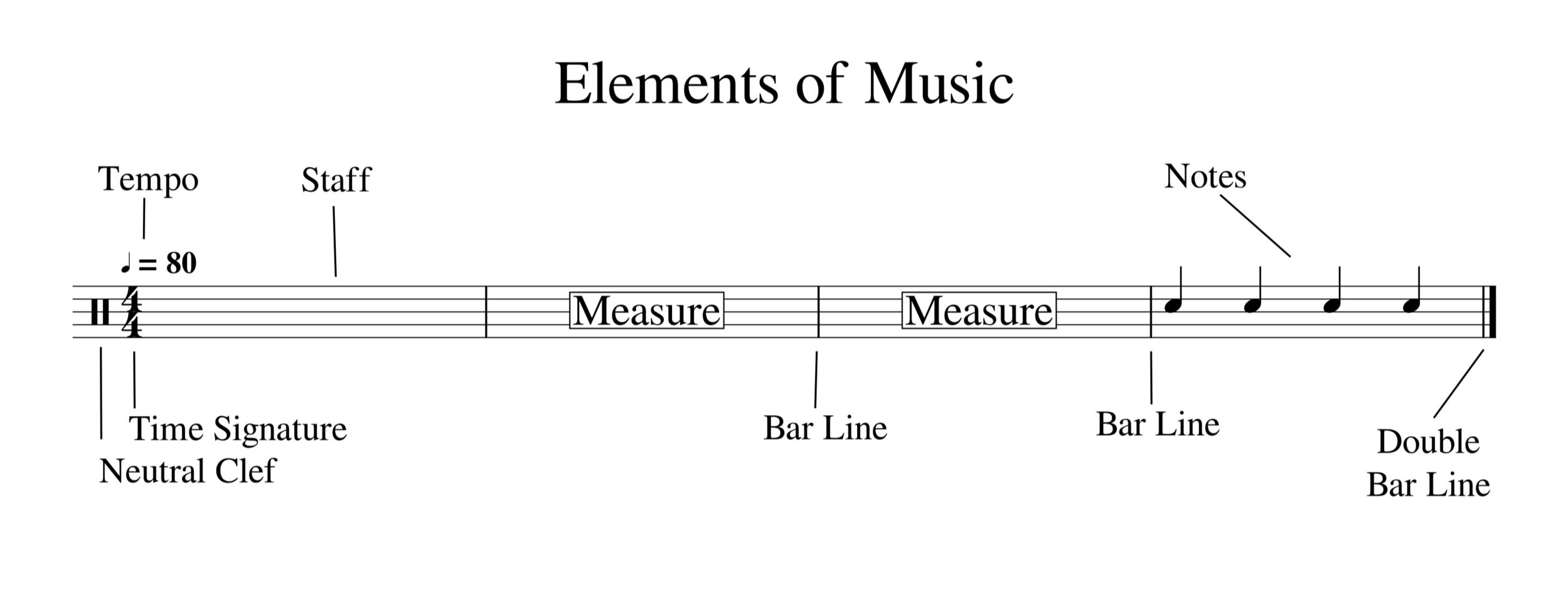Lesson 1: The Elements of Music - Rhythm and Reading Series
Overview: This video introduces the symbols used in music notation and what they mean. I show and discuss the staff, the neutral clef, measures, bar lines, double bar lines, time signature, notes and tempo.
Let's get started by looking at the basic elements of music.
Music is written on a staff and that's represented by 5 lines and 4 spaces (Fig. 1). The staff tells a musician, like a piano player or a trumpet player, what note to play in the scale. Each line and space represents a specific note to play.
Fig. 1
Now for drums, we don't always have pitches like a piano. When we play a drum set, we aren't playing specific notes, we are playing all different instruments. So for us drummers, the neutral clef (Fig. 1) means that the line and spaces of the staff don't represent pitch. The clef looks a little like an 11 and it means that we should look for a key to the staff.
The key is just a separate note somewhere at the beginning of the composition or drum method book that spells out which lines and spaces represent which instruments. Figure 2 is an example drum key from the beginning of a drum method book. We are able to remember those assignments and when we play the music, perform the rhythms on the correct instruments.
Fig. 2
The staff is also representative of time and if you've ever played a game like Guitar Hero or Rock Band, then you know how the screen scrolls by and you hit the buttons for the correct notes in rhythm. Playing music is actually really similar. You read left to right and as you perform the piece, you stay in time and you play the rhythms as they pop up.
To make music easier to read, the staff is split up into smaller parts. Those parts are called measures and they are created by what are called bar lines. The end of the piece of music is indicated by the double bar line. It's the period at the end of the sentence. You can see these in Figure 1.
I said measures split the staff in to equal parts and that the staff is time. So the next question is "how long does the measure last?"
The way the composer tells the performer how long a measure lasts is with the time signature (Fig. 1). I'm going to go into a lot more detail on time signatures in future videos but for the time being, I'm just gonna say that this specific time signature tells the player there are 4 beats in a measure and a quarter note gets the beat.
So, what's a quarter note? Quarter notes are one of the types of notes used to represent rhythm. The time signature says that the measure lasts for 4 quarter notes, and you can see that in the example. There are 4 quarter notes in each measure (Fig. 3).
Fig. 3
Now we know a lot about the music. We know what instruments are playing; we can see the music measured evenly; we know there are 4 measures of 4/4 time; and we can see where the music ends. Now we need to know how fast to play the music and that is indicated by the tempo. The tempo in this case is Quarter note equals 80 (Fig. 4).
Fig. 4
80 is referring to a unit of time called beats per minute (BPM). You're actually kind of familiar with this idea. When you look at a clock and the second hand clicks by, it's actually clicking 60 beats per minute. That's because there's 60 seconds in a minute. There's one click every second. When the tempo is 80 beats per minute, there are 80 clicks in that minute. It's almost like there are 80 seconds in a minute.
There’s a device called a metronome that helps us count that out. The metronome is a device for tempo and it clicks at the tempo it’s set. That click can be set for 80 BPM, and we know from the example, that the quarter note equals 80 BPM. That means that the click we are hearing is the same speed that the quarter note should be played. Now we have a reference point. You can get the same metronome I use in the videos by clicking on the image (paid link).
To summarize it all, I have a click going at 80 BPM and that's the speed of my quarter notes. The time signature tells me that I'll have four clicks of the metronome in every measure. I know what instrument to play because of the neutral clef and the staff. This is the backdrop for real music. The quarter notes I used in this example represent the first rhythm we'll dig into in the next video. Learning about all the other types of notes is really what this whole series is going to be about.
Be sure to pick up your copy of Joel Rothman's Teaching Rhythm for the next lesson so you can practice along (paid link below).
Please like and subscribe to my YouTube Channel to get updates as I add videos to the series. Thanks for joining me!



